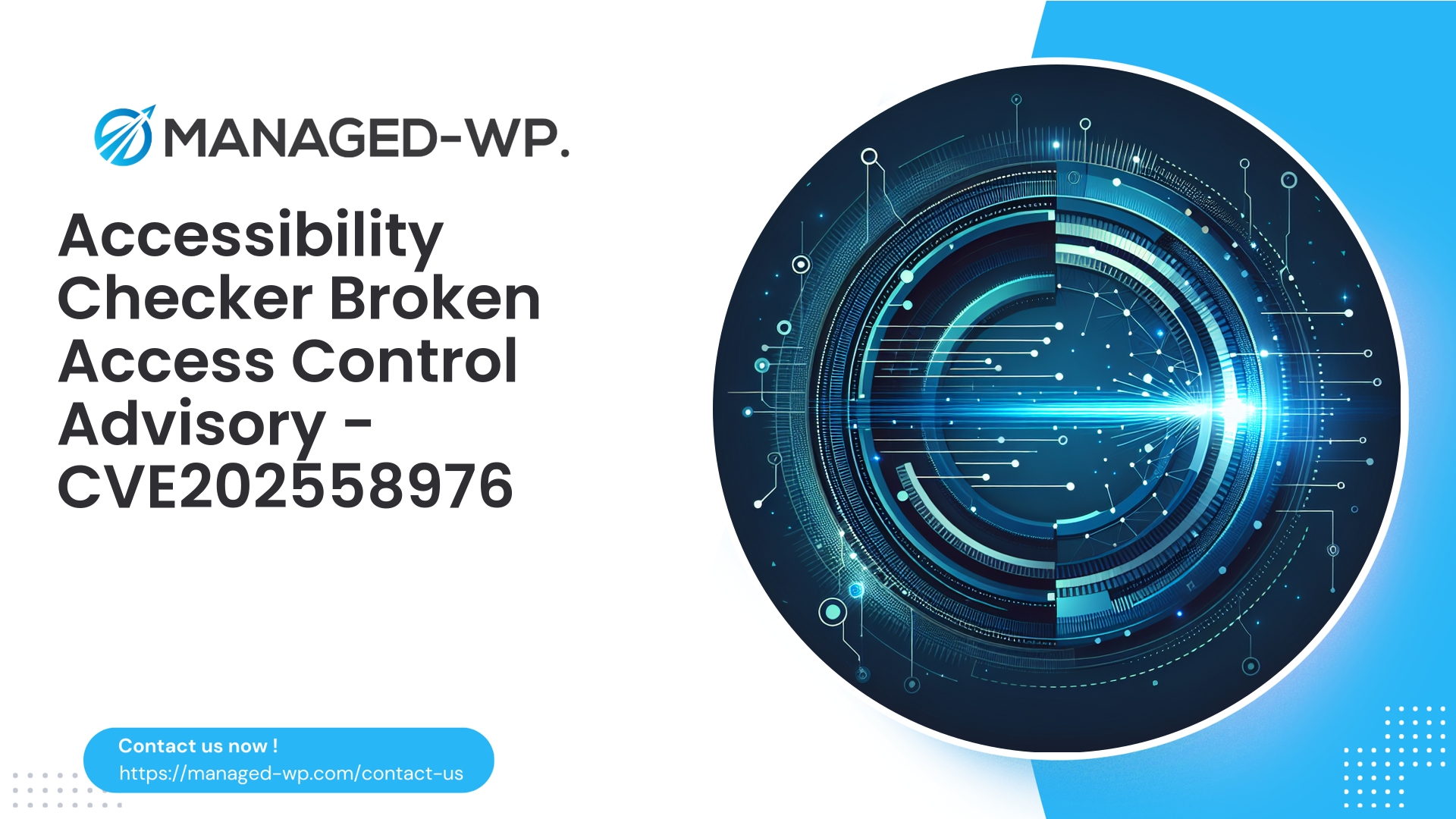| 插件名稱 | Welcart 電子商務 |
|---|---|
| 漏洞類型 | 跨站腳本 (XSS) |
| CVE編號 | CVE-2025-58984 |
| 緊急 | 低的 |
| CVE 發布日期 | 2025-09-09 |
| 來源網址 | CVE-2025-58984 |
緊急安全警報:Welcart 電子商務版本 ≤ 2.11.20 存在儲存型跨站腳本 (XSS) 漏洞 — CVE-2025-58984
執行摘要
您值得信賴的美國 WordPress 安全合作夥伴 Managed-WP 現已發布針對 Welcart 電子商務外掛用戶的緊急安全公告。此插件存在一個儲存型跨站腳本 (XSS) 漏洞,漏洞編號為 CVE-2025-58984,影響插件版本 2.11.20 及更早版本。此漏洞允許擁有編輯權限的使用者註入惡意 JavaScript 程式碼,可在您網站訪客的瀏覽器中執行,可能會損害您商店的完整性並損害客戶信任。該漏洞已在版本 2.11.21 中修復。我們強烈建議您立即更新。如果立即更新不便,請採取以下緩解策略來保護您的環境。
作為經驗豐富的安全專家,我們專注於 WordPress 管理和保護,Managed-WP 致力於引導您了解漏洞詳情、其實際影響、檢測方法和強大的緩解措施,以便您可以維護安全的電子商務環境。
目錄
- 事件概述
- 技術說明
- 風險評估:誰會受到影響以及原因
- 潛在攻擊途徑和場景
- 檢測方法和指標
- 立即行動:接下來一小時內該做什麼
- 中期策略:強化與虛擬修補
- Web應用程式防火牆(WAF)最佳實踐
- 補丁後驗證和長期修復
- 事件回應工作流程
- 持續安全行動
- Managed-WP 如何為您提供支持
- 最終建議和資源
事件概述
安全研究人員發現,適用於 WordPress 2.11.20 及更早版本的 Welcart 電子商務外掛程式存在儲存型跨站腳本攻擊 (XSS) 漏洞。此漏洞允許擁有編輯權限(或同等權限)的使用者註入腳本,這些腳本會被儲存並在其他查看受影響內容的使用者瀏覽器中執行。利用此漏洞可能導致多種攻擊行為,包括未經授權的重定向、竊取會話 cookie 或註入惡意負載。
此漏洞無法在沒有憑證的情況下遠端利用;然而,編輯權限通常會分配給內部員工或承包商,這顯著增加了暴露風險。與此問題相關的通用漏洞揭露識別碼為 CVE-2025-58984,其 CVSS 評分顯示其影響程度為低到中等。
技術說明
- 漏洞類型: 儲存型跨站腳本攻擊(XSS)
- 受影響版本: Welcart 電子商務 ≤ 2.11.20
- 需要權限: 編輯或同等認證角色
- 修復版本: 2.11.21 及更高版本
- CVE 參考編號: CVE-2025-58984
- 風險特徵: 中等-取決於注入情境和執行環境
本質上,此漏洞允許儲存的資料輸入繞過輸出清理機制,從而使惡意 JavaScript 程式碼能夠持久存在於您的網站內容中,並在不知情的訪客瀏覽器中執行。 Managed-WP 不會公佈漏洞利用詳情,以限制攻擊自動化,而是專注於提供實際的防禦措施。
風險評估:誰會受到影響以及原因
- 任何經營 Welcart 電子商務外掛程式版本 2.11.20 或更早版本的 WordPress 網站。
- 在沒有嚴格控制和多因素身份驗證 (MFA) 的情況下,為多個使用者指派編輯級權限的網站。
- 廣泛共享、缺乏監控或憑證管理薄弱的 Web 資產的編輯帳戶。
- 流量龐大的電子商務網站,注入的腳本可能會迅速影響大量客戶。
- 將內容轉發到電子郵件或外部管道的網站,會使客戶面臨網站外部惡意負載的風險,從而加劇風險。
鑑於編輯帳戶通常擁有廣泛的內容修改權限,被盜或洩漏的憑證會構成嚴重的安全威脅。健全的角色管理和存取控制策略是必要的緩解措施。
潛在攻擊途徑和場景
- 惡意編輯帳戶在產品描述中插入 JavaScript 重定向,誘騙訪客進入虛假的結帳流程,並將他們引導至攻擊者控制的網域。
- 注入的腳本會捕獲會話 cookie 或擊鍵訊息,從而竊取管理員憑證,實現對網站的完全控制。
- 透過腳本修改店鋪內容,顯示欺詐性的信任訊號或插入欺騙性廣告,損害品牌聲譽。
- 部署用戶端加密貨幣挖礦程式會消耗訪客資源並降低使用者體驗。
- 透過隱藏表單作業更改訂單詳情,例如收貨地址或價格折扣,以實施詐欺。
筆記: 儲存型 XSS 攻擊通常被用作更嚴重漏洞的跳板,這取決於注入的程式碼如何與會話令牌、cookie、內容安全策略和其他伺服器端保護措施互動。
檢測方法和指標
注意觀察以下可能表示存在剝削或針對性的跡象:
- 產品描述、貼文或頁面中出現意外或未經授權的編輯,包括難以理解的 HTML 或 JavaScript 程式碼。
- 陌生人的出現
<script標籤或可疑事件處理程序(例如,點選,錯誤)在頁面原始碼中。 - 瀏覽器控制台錯誤,提示腳本被封鎖或違反 CSP 協定。
- 網路流量日誌中發現向未知域發出的出站呼叫。
- 分析異常激增,例如跳出率突然增加或可疑的引薦來源。
- 編輯帳戶出現異常登入模式,包括使用新的 IP 位址或在奇怪的時間存取。
- WAF 和防火牆日誌顯示,針對插件端點的可疑腳本有效載荷反覆被攔截。
- 訂單通知郵件收件者報告出現意外重新導向和內容變更的情況。
- CPU和記憶體使用率增加,與嵌入式加密貨幣挖礦活動一致。
專業提示: 在進行修復或取證調查之前,請先儲存相關日誌並備份資料庫。
立即行動:接下來一小時內該做什麼
- 立即修補請將 Welcart 電子商務軟體升級至 2.11.21 或以上版本。升級前務必備份檔案和資料庫。
- 如果無法立即升級:
- 暫時限制編輯權限-停用或降級非必要的編輯帳號。
- 如果可行,請考慮暫時停用該外掛程式或其關鍵功能。
- 強制執行內容審核流程,在發布前審核變更。
- 啟用旨在阻止針對此插件的 XSS 攻擊向量的 Web 應用程式防火牆 (WAF) 規則。
- 重設憑證: 強制所有編輯和管理員重設密碼,實施強密碼策略,並儘可能啟用多因素身份驗證。
- 掃描惡意內容: 檢查資料庫中的貼文、頁面和產品描述中是否存在嵌入式腳本標籤或可疑的 HTML 程式碼。
- 監視器: 密切注意訪問日誌、入侵偵測系統和異常追蹤器。
- 備份: 在進行任何內容或配置變更之前,立即拍攝快照,以便輕鬆回滾。
中期策略:強化與虛擬修補
請考慮以下幾種提升網站安全態勢的策略:
- 角色最小化: 限制擁有編輯權限的使用者數量;採用外掛程式或策略來嚴格限制權限。
- 內容清理: 使用 WordPress 過濾器和 kses 將安全性的 HTML 列入白名單,允許貢獻者使用,並阻止不受信任的輸入。
- 編輯流程: 引入內容提交的強制性管理員審核步驟。
- 帳戶安全: 強制執行多因素身份驗證 (MFA),停用密碼重複使用,並定期進行憑證審核。
- 功能限制: 在 Welcart 設定中停用不必要的 HTML 編輯器或接受原始 HTML 輸入的欄位。
- 內容安全策略(CSP): 首先以「僅報告」模式部署 CSP,以降低內聯腳本風險並協助偵測違規行為。
- 安全 Cookie: 實作 HttpOnly、Secure(僅限 HTTPS)和 SameSite cookie 屬性,以防止透過 XSS 進行竊取。
- 惡意軟體掃描: 定期使用自動掃描器偵測注入模式和未經授權的檔案變更。
透過WAF進行虛擬補丁:
- 設定您的 WAF 以檢查傳送至 Welcart 管理端點的 POST 請求。
- 阻止包含以下內容的提交:
- tags or encoded variants.
- 事件處理程序屬性
錯誤,點選,載入. - 用於偷偷植入腳本的 JavaScript 和資料 URI。
- 混淆的有效載荷,例如 Base64 或非常規編碼。
- 持續監控 WAF 日誌,以調整規則並減少誤報。
- 如果可用,請啟動專門針對 CVE-2025-58984 利用模式的基於啟發式的虛擬修補程式。
Web應用程式防火牆(WAF)最佳實踐
Managed-WP 會根據使用者權限上下文部署針對儲存型 XSS 漏洞的客製化 WAF 保護:
- 嚴格監控和過濾插件特定的管理員 POST 和 PUT 請求。
- 透過解碼 URL 編碼的有效載荷並移除多餘的編碼層來規範化輸入。
- 透過有效載荷內容中的啟發式模式檢測混淆嘗試。
- 在可行的情況下實施輸出重寫,以動態地抵消內聯腳本的影響。
- 應用速率限制和流量限制來降低自動化風險。
- 實施基於角色和地理位置的存取控制,以收緊管理請求入口。
筆記: WAF規則必須兼顧安全性和易用性。過於激進的過濾可能會幹擾合法內容的提交。我們建議採用多層防禦:及時修補漏洞、使用客製化的WAF進行虛擬修補,以及嚴格的內容管理。
補丁後驗證和長期修復
更新完成後,請執行以下驗證:
- 確認插件版本已升級至 2.11.21 或更高版本。
- 對系統進行全面掃描,檢查是否有殘留的注入腳本或未經授權的內容。
- 在漏洞出現期間審查內容變更日誌,並清除或撤銷可疑的編輯。
- 分析 WAF 日誌,以驗證緩解期間虛擬補丁的有效性。
- 確保 CSP 和安全性 cookie 設定已正確部署並正常運作。
- 使用非破壞性方法測試面向公眾和管理員的頁面是否存在殘留的 XSS 執行。
- 如果發現惡意內容,請執行完整的事件回應協定(請參閱下面的檢查清單)。
測試提示: 避免發布漏洞或複現程式碼;盡可能使用安全有效載荷在測試環境中測試防禦機制。
事件回應工作流程
- 包含: 如果偵測到系統遭到入侵,請暫時隔離或限制對網站或管理後台的存取。立即套用所有可用的補丁和虛擬補丁。
- 保存證據: 將所有相關日誌、快照和備份以唯讀模式保存。
- 確定範圍: 確定所有受影響的內容和受攻擊涉及的帳戶。
- 根除: 移除所有惡意注入腳本,清除後門,並驗證 WordPress 核心、外掛程式和主題的完整性。
- 恢復: 盡可能從乾淨的備份中還原;重置憑證並停用任何已暴露的 API 金鑰。
- 事件後行動: 進行根本原因分析,通知受影響的利害關係人,並實施加強的安全控制措施,包括多因素身分驗證和強制更新。
如果您缺乏內部資源進行事件回應,Managed-WP 可以提供專家協助,以確保快速、全面的復原。
持續安全行動
- 定期進行漏洞掃描,並在安全的情況下啟用插件自動更新。
- 維護異地、不可更改的備份,並定期進行可靠性測試。
- 定期審核使用者角色,清理不活躍帳戶,並執行最小權限原則。
- 強制所有特權使用者帳號進行多因素身份驗證。
- 為便於取證,請保留日誌並進行 90 天滾動存檔。
- 定期部署自動化惡意軟體和注入檢測掃描。
- 對編輯和內容貢獻者進行安全使用 HTML 和風險意識的培訓。
Managed-WP 如何為您提供支持
Managed-WP 提供全面的託管式 WordPress 安全解決方案,結合了主動監控、託管式 Web 應用程式防火牆和專家指導:
- 免費方案: 立即部署必要的保護措施,包括阻止常見 XSS 和注入攻擊的 WAF 規則、惡意軟體掃描以及無限頻寬處理。
- 標準計劃($50/年): 新增自動惡意軟體清除和 IP 黑名單/白名單控制功能。
- 專業版套餐($299/年): 提供每月安全報告、自動漏洞虛擬修補、專屬帳戶管理和託管安全服務。
立即使用 Managed-WP 的免費方案,開始保護您的 WordPress 電子商務網站: https://my.wp-firewall.com/buy/wp-firewall-free-plan/
我們的解決方案可確保您的網站既能立即降低風險,又能提供清晰的升級路徑,從而增強託管安全功能。
最終建議
- 如果您的 Welcart 電子商務外掛程式版本 ≤ 2.11.20,請立即更新至 2.11.21 或更新版本。
- 不要低估被盜用編輯帳戶帶來的風險—實施嚴格的存取控制和多因素身份驗證。
- 採用分層安全方法:及時打補丁、限制存取、使用 WAF、內容清理和持續監控。
- 如果清理或調查超出了您團隊的專業能力,請立即聘請專業的事故回應服務提供者。
我們深知電子商務安全管理至關重要且極具挑戰性。 Managed-WP 致力於透過值得信賴的安全實踐,幫助您降低風險並保護您的線上商店。
保持警惕。
Managed-WP 安全團隊
參考文獻及延伸閱讀
- CVE資料庫:CVE-2025-58984
- 官方 WordPress 安全加固指南 (WordPress.org)
- OWASP Top 10:防止跨站腳本攻擊的最佳實踐
注意:出於負責任的安全實踐,本安全公告避免分享漏洞利用程式碼或重現步驟。如需協助處理可疑內容或安全事件,請聯絡 Managed-WP 或經驗豐富的安全團隊。



















